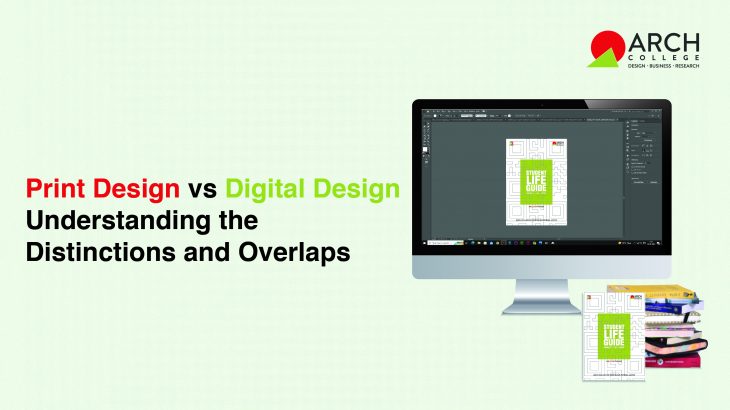In an era where graphics and ink dance together, print design paints tales that you can touch, while digital design weaves ideas that you can play with! Thinking about what could be better and if in the design industry you need the contribution of both? Read along to know more.
Design is now an important part of many businesses in the digital age. Whether they’re making an interesting ad or a website that’s user friendly, designers are an important part of getting information across and improving the user experience as a whole. Degree in Graphic Designing at ARCH College of Design & Business includes many different forms of design, and it will guide you as a designer to know the differences and similarities between print design and digital design if you want to do well in this field. This blog looks at the distinctions and similarities between print design and digital design, focusing on what makes them special.
A Quick Look into Print Design and Digital Design
Print design is the process of making visual objects that are meant to be printed on paper. It includes an extensive variety of things, like handouts, flyers, signs, publications, media packages, and more. Print design concentrates on creating the final result in mind, taking into account things like the substance of paper, the printing process, and how the colors will look. It takes paying close attention to every detail and knowing how patterns look on real surfaces.
Digital design, on the contrary, is the process of making visual content for digital channels like websites, mobile apps, social handles, and engaging media. It takes advantage of what digital devices can do, like graphics, interactions, and material that changes over time. To make digital experiences that are fun and easy to use, digital designers need to know how to use a variety of software devices, code languages, and user experience (UX) concepts.
Know the Distinctions Between Print Design and Digital Design
- Medium
The most important difference between print design and internet design is how the designs are meant to be seen. Print design involves real resources, so designers can experiment with different textures, finishes, and forms that people can touch. With a Graphic Design Bachelor Degree, you have the best possibilities of acquiring this skill. Digital design, on the opposing side, is made for screens, so designers can add movements, changes, and engaging features to their work.
- Versatility and Interaction
Compared to print design, digital design has greater versatility and interaction. With digital mediums, creators can make realistic experiences by adding motion, sound, and user involvement. They can use graphics to help users, make choices and screens that users can interact with, and add changeable content that changes based on what the user does. Even though print design is rigid, it continues to produce powerful images with careful use of layout, font, and color.
- Time and Cost
In contrast to digital design, print design frequently incurs higher manufacturing expenses and takes longer to finish. Printing costs money because it needs real materials and specialized tools. Also, print projects usually need to go through prepress steps like color isolation and editing, which makes the whole process a time-consuming task. Digital design, on the other hand, lets you make changes and updates right away without having to print new copies. This saves a lot of time and money.
The Overlaps and Common Considerations
- Typography and Layout
Both print and digital design need good typography and layout. Typography, well taught at ARCH College of Design & Business with Bachelor of Graphic Design programs, works well makes text easy to read and sends the tone or message that was intended. But designers have to take into account how each medium is different. Print designers have to think about how easy it is to read at distinct sizes and how the paper feels and looks. On the contrary side, digital designers have to think about screen sizes, flexible design concepts, and the fact that digital text changes all the time.
- Branding and Visual Identity
Both in paper and digital mediums, branding and visual identity must be consistent. To keep a uniform company image, logos, color ideas, and fonts should all stay the same. Designers have to change these features to fit the needs of each medium and make sure that people recognize and remember the brand as was earlier to branding. A good branding plan makes sure that people are able to identify a brand on diverse mediums, whether they are reading it in print or viewing it on a screen.
- The Changing Landscape: The Merging of Print and Digital Designs
As technology gets better, there is less and less difference between print design and digital design. When print design and digital design come together, it opens up new ways for artistic expression. Presently, designers are looking into augmented reality (AR) and virtual reality (VR) in order to bridge the distance between real-world interactions and digital ones. People are using QR codes, NFC tags, and engaging with print materials for linking print materials to digital content in a smooth way. This means that designers can use the best parts of both forms to make experiences that are intense and interesting for their viewers.
Bottom Line
With ARCH’s B. Des (UG, 4 yr), Masters in Design Entrepreneurship (PG, 2 yr), BA International (2+1+1) using the best parts of each medium and accepting the merging of print and digital designs, designers can make events that are interesting, intriguing, and leave an indelible mark on their audiences.
